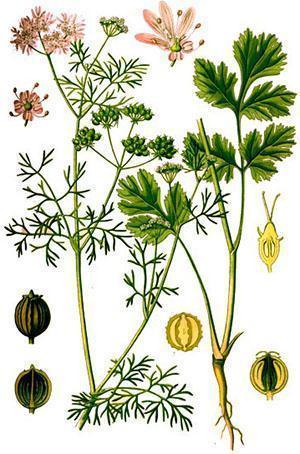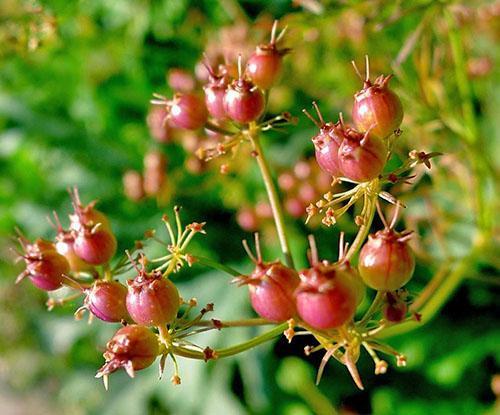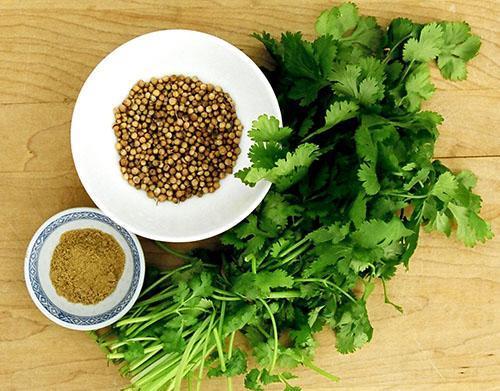Photo of cilantro and interesting facts about the plant
 Human acquaintance with the majority of spicy herbs took place in ancient times. Coriandrum sativum belongs to this number, but the inhabitants of modern Europe, Asia and America, who grow cilantro, may mean different plants. And Russians don't always know that cilantro and coriander are different names that refer to the same culture.
Human acquaintance with the majority of spicy herbs took place in ancient times. Coriandrum sativum belongs to this number, but the inhabitants of modern Europe, Asia and America, who grow cilantro, may mean different plants. And Russians don't always know that cilantro and coriander are different names that refer to the same culture.
The cilantro shown in the photo is a grass that has a straight and branched stem, as well as whole three-lobed leaves of a basal rosette and pinnately dissected on the stem, that is, cilantro has two types of leaves: the lower basal with jagged edges and the upper, which are divided into lobules with different segments.
The name adopted in the international classification goes back to the Greek word koriannon or, according to other sources, koros, which means beetle, bug.
This version has a right to exist, since the cilantro grass, in the photo, is famous for its bright aroma, reminiscent of the smell of these odorous insects.

One plant and two names: cilantro greens, coriander seeds
 Unsurprisingly, coriander foliage, cilantro, and plant seeds are used in very different ways and exhibit dissimilar properties in cooking. Moreover, in national cuisines, leaves and grains are not equally popular:
Unsurprisingly, coriander foliage, cilantro, and plant seeds are used in very different ways and exhibit dissimilar properties in cooking. Moreover, in national cuisines, leaves and grains are not equally popular:
- With a refreshing, pungent aroma and a bitter aftertaste, greens are good in salads, meat dishes and sauces. Fresh cilantro leaves, as in the photo of the plant, are mainly used in the cuisine of southern peoples, which is probably due to the plant's ability to secrete substances that prevent rotting and the development of harmful bacteria.
- Cilantro seeds called "coriander" have a sweeter, softer and more oily aroma. Therefore, they are used to flavor sausages and vegetable dishes, drinks, soups and baked goods.
Use and cultivation of cilantro in the countries of the world
 In different countries and corners of the world, the plant is called not only cilantro and coriander, but also kashnich, chilantro and kishnish, chatra, kushtumburu, kolyandra and hamem. Externally, plants from the umbrella family have many similarities. What cilantro looks like is clearly visible in the photo. Because of the similarity to parsley leaves, cilantro greens are called Chinese, Arabic, Chinese and Mexican parsley.
In different countries and corners of the world, the plant is called not only cilantro and coriander, but also kashnich, chilantro and kishnish, chatra, kushtumburu, kolyandra and hamem. Externally, plants from the umbrella family have many similarities. What cilantro looks like is clearly visible in the photo. Because of the similarity to parsley leaves, cilantro greens are called Chinese, Arabic, Chinese and Mexican parsley.
In Indonesian cuisine, coriander is known as ketumbar, while Indians call the spice dhania and grow cilantro to make a mixture of curry and masala spices. In India, coriander is a part of traditional cuisine, and it is mentioned in the oldest Sanskrit texts.
The history of growing cilantro since ancient times
 Cilantro is mentioned in the Iberian papyrus, dedicated to the description of natural medicinal plants and poisons and dating back to 1550 BC. Fossilized coriander seeds were found by paleobotanists in the tombs of the XXI dynasty of Egyptian pharaohs. It is believed that the manna described in verse 16:31 of the Bible book of Exodus is the seeds of white coriander.
Cilantro is mentioned in the Iberian papyrus, dedicated to the description of natural medicinal plants and poisons and dating back to 1550 BC. Fossilized coriander seeds were found by paleobotanists in the tombs of the XXI dynasty of Egyptian pharaohs. It is believed that the manna described in verse 16:31 of the Bible book of Exodus is the seeds of white coriander.
During the heyday of the Hellenic and Roman civilizations, cilantro seeds called coriander, and perhaps herbs, were widely used as a medicine and spice.Hippocrates writes about the plant in 400 BC, and under the ruins of Pompeii, buried under ash in the 1st century BC, archaeologists also find round coriander seeds. The image of the cilantro plant has been preserved, in the photo, from the book of Dioscorides.
With cohorts of Roman warriors, the plant came to Gaul, and later to Britain. With ground coriander seeds and spicy herbs, the invaders flavored unleavened barley porridge and preserved the freshness of the meat.
In the southeast of Great Britain, you can still see the wild-growing coriander, which does not let you forget about the distant history of the country.
How cilantro was grown in Russia
 In the Crimea, Central Asia and the North Caucasus, the wild coriander is also a memory of how troops and caravans of Sarmatians, Greeks and Persians, Turks and other peoples who have long been engaged in the cultivation of cilantro passed through these lands. Information about the cultivated planting of plants in the gardens of Russia dates back to the second half of the 18th century, and they mention the name "kishnets", which is close to the pronunciation of "geshnes" in Farsi and Turkish "kishnis", speaks of the eastern route of the plant entering Russia.
In the Crimea, Central Asia and the North Caucasus, the wild coriander is also a memory of how troops and caravans of Sarmatians, Greeks and Persians, Turks and other peoples who have long been engaged in the cultivation of cilantro passed through these lands. Information about the cultivated planting of plants in the gardens of Russia dates back to the second half of the 18th century, and they mention the name "kishnets", which is close to the pronunciation of "geshnes" in Farsi and Turkish "kishnis", speaks of the eastern route of the plant entering Russia.
Mass crops of this culture began only in the 19th century, when Count P.I. Apraksin brought the seed of spicy plants, including coriander, from Spain.
Kinze, who was then called kolyandra, liked it so much on the black soil of the Voronezh province that the plant began to displace the more popular anise.
How to grow cilantro for herbs and seeds?
 Indeed, cilantro in Russian conditions has shown itself to be an early ripening, unpretentious culture that easily tolerates frost. To grow cilantro for greens and full-fledged seeds, a fairly fertile soil and plenty of light are needed, otherwise the stems will be elongated, with rare weak foliage and inflorescences-baskets, consisting of barren flowers. By the way, high temperatures also negatively affect seed formation. If the air warms up above 35 ° C, pollination does not occur, and the number of barren flowers increases sharply.
Indeed, cilantro in Russian conditions has shown itself to be an early ripening, unpretentious culture that easily tolerates frost. To grow cilantro for greens and full-fledged seeds, a fairly fertile soil and plenty of light are needed, otherwise the stems will be elongated, with rare weak foliage and inflorescences-baskets, consisting of barren flowers. By the way, high temperatures also negatively affect seed formation. If the air warms up above 35 ° C, pollination does not occur, and the number of barren flowers increases sharply.
Sowing cilantro seeds, called coriander, is best in spring, from March to early May, when the soil has not lost moisture from melted snow. So that subsequently the plant does not experience a lack of moisture, planting watered at least once every 8-10 days, when the soil under the plants becomes dry without natural precipitation. Coriander feels the greatest need for water when stems begin to rise above the rosettes of leaves and flower stalks form. At this time, cilantro grass is watered in the photo, and the soil is mulched to retain moisture.
When to harvest cilantro and coriander seeds?
 If the goal of the gardener is to get fragrant greenery, then you need to cut the foliage in the rosette phase, before the inflorescences appear. The most valuable are the basal leaves growing on long petioles. When cilantro is harvested, the height of the petioles does not exceed 15 - 20 cm.
If the goal of the gardener is to get fragrant greenery, then you need to cut the foliage in the rosette phase, before the inflorescences appear. The most valuable are the basal leaves growing on long petioles. When cilantro is harvested, the height of the petioles does not exceed 15 - 20 cm.
 The foliage growing higher along the stem gradually loses its three-lobed shape, becomes feathery, elongated and small. After cutting the greens, the coriander is fed. And then from July to September the time comes when cilantro is harvested already in the form of seeds.
The foliage growing higher along the stem gradually loses its three-lobed shape, becomes feathery, elongated and small. After cutting the greens, the coriander is fed. And then from July to September the time comes when cilantro is harvested already in the form of seeds.
Re-sowing cilantro is carried out only with a decline in summer heat, from August to October.
In many regions of the world, for example, in the Middle East and North Africa, in Asia and the Mediterranean countries, in eastern Europe, India and Russia, coriander is a seed crop, cilantro is grown on an industrial scale, and the lion's share of the crop is not greens, but spicy seeds.
Coriander and its rivals in Asia and the Americas
In the 15th-16th centuries, coriander was brought to the American continent on the ships of the Portuguese and Spanish conquistadors.
Today in the USA, and especially in Latin America, cilantro greens and seeds of this plant are extremely popular as a seasoning for national cuisine.
 Interestingly, in the American continent, coriander or culantro can be called the plant Eryngium foetidum, which has a similar taste to cilantro and is native to Central America. You can consider the rival of cilantro in the photo of the plant. Young leaves of Eryngium foetidum are used as a seasoning in the New World and in a number of Asian countries. Long or Mexican coriander, cultivated by farmers in Costa Rica, has medicinal properties and can be used to neutralize inflammation and relieve pain.
Interestingly, in the American continent, coriander or culantro can be called the plant Eryngium foetidum, which has a similar taste to cilantro and is native to Central America. You can consider the rival of cilantro in the photo of the plant. Young leaves of Eryngium foetidum are used as a seasoning in the New World and in a number of Asian countries. Long or Mexican coriander, cultivated by farmers in Costa Rica, has medicinal properties and can be used to neutralize inflammation and relieve pain.
 Interesting facts about cilantro include the existence of a plant in Vietnam and Malaysia, also called coriander. The local spice belongs to the Buckwheat family. It is Polygonum odoratum or smelly knotweed. Vietnamese coriander is grown alongside rice and other traditional crops. The highlander is of constant interest to tourists who have not previously encountered an unknown spice. The plant is used for making national North Vietnamese soups and noodle dishes.
Interesting facts about cilantro include the existence of a plant in Vietnam and Malaysia, also called coriander. The local spice belongs to the Buckwheat family. It is Polygonum odoratum or smelly knotweed. Vietnamese coriander is grown alongside rice and other traditional crops. The highlander is of constant interest to tourists who have not previously encountered an unknown spice. The plant is used for making national North Vietnamese soups and noodle dishes.